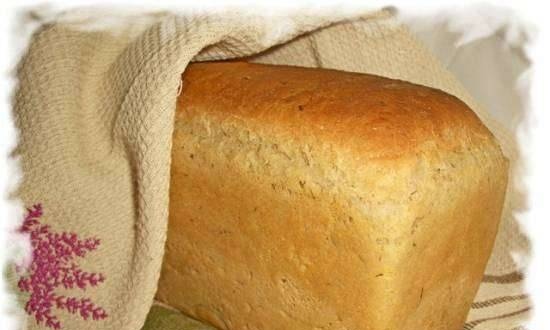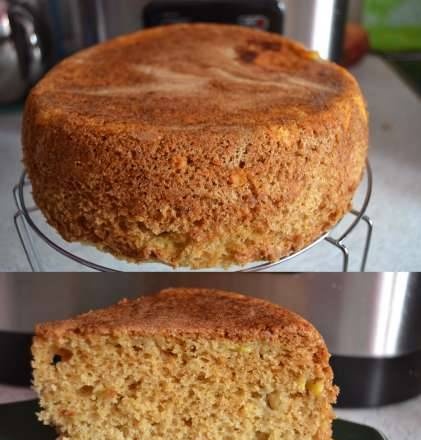|
 Bread is one of the most important food items. The nutritional value of bread depends on its chemical composition and digestibility. The bread contains carbohydrates (42-50%, mainly starch), proteins (6-8%), a small amount of fat (in ordinary bread), minerals, vitamins B and PP, fiber and water (40-48% ). The average calorie content in 100 g of bread, depending on the type and type of flour, the amount of additions and the baking method, is 220-280 kcal. Bread is one of the most important food items. The nutritional value of bread depends on its chemical composition and digestibility. The bread contains carbohydrates (42-50%, mainly starch), proteins (6-8%), a small amount of fat (in ordinary bread), minerals, vitamins B and PP, fiber and water (40-48% ). The average calorie content in 100 g of bread, depending on the type and type of flour, the amount of additions and the baking method, is 220-280 kcal.
Bread made from wheat flour of the highest and first grades, as well as a hearth containing less moisture, has a higher calorie content than bread made from flour of lower grades (molded).
Requirements for the quality of bread and bakery products. The organoleptic method evaluates the appearance, condition of the crust and crumb, taste and smell. The moisture, acidity and porosity of bread is determined by the physical and chemical method.
Bread shape must be correct and appropriate for the class. For tin bread, the crust is slightly convex, not wrinkled, without lateral sagging. The hearth is oval, elongated or round in shape, not spreading, without side sagging and imprints. The surface is smooth, no cracks or bubbles.
Peel color brown to dark brown rye bread, golden yellow to light brown wheat bread.
Peel thickness determine on the cut, it should be no more than 3-4 mm.
Bread crumb should be well baked, elastic, not sticky, not wet, without lumps, traces of impurities, voids and hardening, with uniform porosity. After light pressure, the crumb should return to its original shape. The bread should be fresh, impure and not crumbly.
The taste and smell of bread must correspond to a certain grade. Bitter, musty and other tastes and smells are not allowed. No crunch should be felt when chewing bread.
Bread moisture depends on the type and grade of flour, recipe, baking method and is standardized by standards. Bread with high moisture content has a dense crumbling crumb, a lower calorie content and is less well absorbed by the body. Bread with very low moisture content is drier and stale quickly. The highest moisture content is in rye bread - up to 51%, the lowest in baked goods - 32-34%, the moisture content of wheat bread is 43-45%.
Acidity of bread mainly due to the accumulation of lactic acid formed during the fermentation of the dough. It significantly affects the quality of the bread. If the acidity is insufficient, the bread has a bland taste, and if it is too high, it tastes sour. Acidity changes depending on the type and grade of flour, the method of preparing the dough. The acidity of rye bread is higher than that of wheat bread.
The acidity of rye bread is 11-12 °, wheat bread is 3-4 °.
The porosity of the bread refers to the ratio of pore volume to total crumb volume, expressed as a percentage. The presence of pores in bread contributes to its fuller and faster digestibility; the higher the grade of the products, the greater their porosity. The porosity of rye bread is 45-51%, wheat from wallpaper flour - 54%, wheat from first grade flour - 65-68%. Shaped bread has a higher porosity than hearth.
Bread vices... Bread defects can occur when using poor-quality raw materials, violation of the technological process, transportation and storage rules. Distinguish between defects in appearance, crumb, taste and smell.
Defects in appearance... The wrong form of bread is obtained as a result of a violation of production technology, poor quality flour, and improper transportation. In case of insufficient proofing, the bread has a smaller volume and a strongly convex top crust.Proofing for too long results in a concave top crust on tin bread and a loose hearth. With a close fit, the bottom products form imprints, that is, side crusts are absent or turn out to be pale. The reason for the violation of the shape of the bread can be incorrect stacking of hot products during transportation and storage.
Tears and cracks in the crust are formed when the dough is insufficiently proofed, there is no steam and the oven temperature is too high.
Burnt and too thick crust is the result of too high oven temperature or too long baking. If there is no steam in the oven, the bread crust does not have a gloss.
A pale crust is obtained when baking is low or using low quality flour.
Crumb defects. Neopromes - lumps of flour, crusts of bread soaked and added to the dough, pieces of salt. A non-mixture is formed as a result of insufficient kneading of bread.
Peeling of crust from crumb is a sign of insufficiently fermented dough baked at very high temperatures. At the same time, a crust appears very quickly, under which carbon dioxide and vapors accumulate, tearing it off the crumb. Laying hot bread too high on its side can also cause this defect.
Zakal is a dense, non-porous, moist crumb layer that usually forms near the lower crust. Tempering occurs when the dough is insufficiently baked, the hearth temperature of the oven is low, and hot bread is densely packed.
A crumbly crumb happens with an insufficient amount of water in the dough and long-term storage.
Uneven porosity of bread occurs as a result of poor dough blooming or insufficient fermented dough when baking.
Non-baked crumb - its inelastic, moist and sticky consistency. The depression formed by pressing on the crumb disappears slowly. This defect occurs when there is an excessive amount of water in the dough, insufficient baking or using poor quality flour.
Defects of taste and smell... Abnormal taste - salty, insipid, too sour or bitter - arises as a result of a violation of the recipe, baking bread from unfermented or fermented dough, the use of old flour stored in poor conditions.
Extraneous odors (musty, moldy, etc.) appear when baking bread from low-quality raw materials and when storing bread next to odorous substances.
The crunch on the teeth is felt when there is sand in the bread.
Stale bread occurs during long-term storage and is due to the state of starch and proteins. As a result of starch paste aging and moisture loss, the crust loses its elasticity, becomes rubbery and wrinkled, and the crumb becomes crumbly, tough and coarse. Wheat bread hardens faster than rye bread.
When the bread is heated, the starch absorbs moisture again and the product softens. Moisten the crust with water when freshening the bread.
Diseases of bread. Potato disease Caused by potato sticks that may be present in flour. It strikes bread made from wheat flour in the hot season. The crumb of the bread softens, stretches with threads when breaking and acquires an unpleasant odor. You cannot eat such bread. Acid prevents the development of these microorganisms, therefore rye bread, which has a higher acidity, is not susceptible to this disease.
Mold formation is observed with high humidity of bread, its storage in a warm or damp room, as well as with sharp temperature fluctuations during storage. Green, scooping or gray mold appears on the bread, which gives it an unpleasant taste and smell.
Cretaceous disease caused by yeast. White spots appear on the crumb of wheat and rye bread, which after a while become powdery, like chalk.
Coca's textbook (edited by S.M. Timokhov), 1982
|
 Bread is one of the most important food items. The nutritional value of bread depends on its chemical composition and digestibility. The bread contains carbohydrates (42-50%, mainly starch), proteins (6-8%), a small amount of fat (in ordinary bread), minerals, vitamins B and PP, fiber and water (40-48% ). The average calorie content in 100 g of bread, depending on the type and type of flour, the amount of additions and the baking method, is 220-280 kcal.
Bread is one of the most important food items. The nutritional value of bread depends on its chemical composition and digestibility. The bread contains carbohydrates (42-50%, mainly starch), proteins (6-8%), a small amount of fat (in ordinary bread), minerals, vitamins B and PP, fiber and water (40-48% ). The average calorie content in 100 g of bread, depending on the type and type of flour, the amount of additions and the baking method, is 220-280 kcal.







